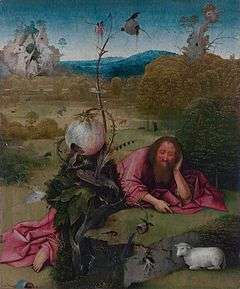Matthew 3:4
Matthew 3:4 is the fourth verse of the third chapter of the Gospel of Matthew in the New Testament. The verse occurs in the section introducing John the Baptist with this verse describing his clothing and diet.
| Matthew 3:4 | |
|---|---|
← 3:3 3:5 → | |
 | |
| Book | Gospel of Matthew |
| Christian Bible part | New Testament |
Content
In the King James Version of the Bible the text reads:
- And the same John had his raiment
- of camel's hair, and a leathern
- girdle about his loins; and his
- meat was locusts and wild honey.
The World English Bible translates the passage as:
- Now John himself wore clothing
- made of camel's hair, with a
- leather belt around his waist.
- His food was locusts and wild honey.
For a collection of other versions see BibleHub Matthew 3:4
Analysis
Biblical scholar John Nolland notes that the decision by the author of Matthew to provide a description of John's clothing and diet shows that both are unusual and worth commenting on. That nowhere in the Gospel does the author give a description of Jesus' or his disciples' clothing thus indicates that they did not adopt any form of atypical dress.[1]
This verse played an important role in the development of Christian monasticism, with John the Baptist viewed as a model ascetic. The sparse food and uncomfortable clothing, including the wearing of hairshirts became seen as the ideal of Christian asceticism. John Calvin wholly rejected this interpretation. He did not see this verse presenting John the Baptist as an ideal, but rather presenting an accurate portrait of one forced to live in the wilderness. To Calvin, John's holiness and popularity arose not because of his asceticism but in spite of it.[2]
The description of John the Baptist's clothing is believed by most scholars to be a deliberate echo that of the prophet Elijah, who in 2 Kings 1:8 is said to wear "a garment of hair and with a leather belt around his waist."[3] Nolland notes that nowhere outside the Gospels is camel hair mentioned as being the clothing of an ascetic. The only reference to camel hair clothing he knows of is in the Apollonius paradoxographus, which speaks of a luxurious garment made of smooth camel hair. More common for the very poor would have been clothing made of goat hair.[4] However, in the Old Testament, in Zachariah 13:4 it is written: “On that day every prophet will be ashamed of their prophetic vision. They will not put on a prophet’s garment of hair in order to deceive", so one can safely assume a garment of hair was the clothing of a prophet in Judaic tradition.[5] In modern times, the Cashmere and Camel Hair Manufacturers' Institute states that "camel hair garments are worn by native desert travelers to protect them from the heat".[6]
John the Baptist's diet has been the centre of much discussion.[7] For many years, the Greek: ἀκρίδες (akrides) was interpreted as referring not to locusts, the insect, but rather to the seed pods of the carob tree. But the Greek word is not used this way,[8] and this notion is generally rejected today.[9] Locusts are mentioned 22 other times in the Bible and all other mentions quite clearly refer to the insect. Locusts are still commonly eaten in Arabia. Eaten either raw or roasted they are quite nutritious and a source of many vitamins. While most insects were considered unclean under Mosaic law, Leviticus 11:22 specifically states that locusts are permitted. Portraying John the Baptist as eating seed pods rather than insects is possibly due to squeamishness about having such a revered figure eating insects and also a belief that a true ascetic should be completely vegetarian.[3][8] What is meant by honey is also disputed. While bee honey was a common food in the area at the time, Jones believes that it refers to the tree gum from the tamarisk tree, a tasteless but nutritious liquid, rather than the honey made by bees.[10]
References
- Nolland, John. The Gospel of Matthew: a Commentary on the Greek Text. Wm. B. Eerdmans Publishing, 2005 pg. 123
- Calvin's Commentary on Matthew 2:4
- Albright, W.F. and C.S. Mann. "Matthew." The Anchor Bible Series. New York: Doubleday & Company, 1971.
- Nolland, John. The Gospel of Matthew: a Commentary on the Greek text. Wm. B. Eerdmans Publishing, 2005 pg. 139
- BibleGateway.com Zachariah 13 NIV
- Cashmere and Camel Hair Fact Sheet Archived 2014-02-16 at the Wayback Machine, published 1999-2013, accessed 27 November 2016
- James A. Kelhoffer, The Diet of John the Baptist: "Locusts and Wild Honey" in Synoptic and Patristic Interpretation, Mohr Siebeck, 2005
- R.T. France, The Gospel of Matthew, Eerdmans, 2007, p. 106
- Dale C. Allison, Matthew: A Shorter Commentary, A&C Black, 2005
- Jones, Alexander. The Gospel According to St. Matthew. London: Geoffrey Chapman, 1965.
| Preceded by Matthew 3:3 |
Gospel of Matthew Chapter 3 |
Succeeded by Matthew 3:5 |